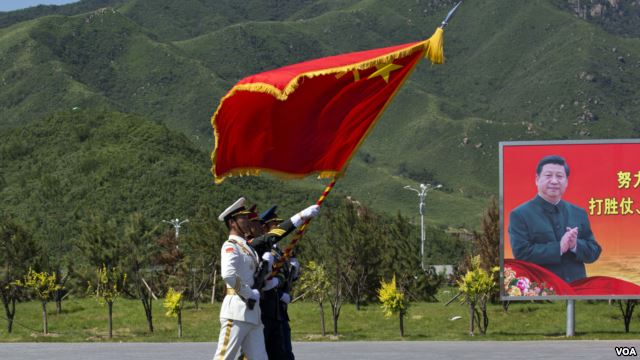Xi Jinping’s China believes to be a superior civilization able to lead the world. Ten million “colonists” are on a CCP’s mission to “civilize” the backward minorities.

Marco Respinti
The daily international newspaper of the CCP, Global Times, has underlined it with emphasis and pride: “China is planning to mobilize more than 10 million young volunteers to help promote cultural, technological and medical development in rural areas by 2020, a move local officials said would help revitalize rural areas that are suffering from an outflow of talented and young workers.” It is stated in a recent document released by the Communist Youth League of China (CYL).
While it would be interesting to analyze the concept of “volunteer” in a totalitarian country, which controls its population with every possible technological device, and where people are free to do just what the regime says and wants, the serious point at stake here is the deployment of an ideological colonial armada aimed to “innovate” several territories and people that the CCP judges to be backward.
The announced task force will serve “[…] as part-time local level officials” to train skilled young people whom the regime is sending to rural areas to reverse the trend of migration from “less-developed regions to developed areas that have better resources and better income.” The emissaries of the CYL will train this skilled youth “in rural governance” using, as the deputy head of a township in Central China’s Hunan Province, Mr. Zhang Linbin, says “[…] science and technology to help the countryside innovate its traditional development models”. This policy, the Global Times specifies, is “[…] vowed to build a number of training bases for young people in rural areas to start their own businesses or find jobs and to train more than 200,000 young people by 2020.”
Decrypting the aseptic language used by the CCP newspaper, this means that Beijing is launching a massive campaign to re-educate large areas of the country in order to “update” their people and bring them to the level envisioned and thus requested by the standards of Mr. Xi Jinping’s socialism for a “New Era,” the political formula that he has launched and implemented since his access to the CCP leadership in 2012 and national power in 2013.
But this trend resembles in many ways Chairman Mao’s declaration of war against the “Four Olds,” when during the Cultural Revolution, the Party aimed to communisticize Chinese society by destroying all the elements of Chinese pre-communist culture that were judged incompatible with the red ideology as useless and even dangerous relics of the past: Old Customs, Old Culture, Old Habits, and Old Ideas.
The parallel is also drawn by The Guardian which writes of “[…] fears of a return” to “brutal” “methods” “of 50 years ago.” Poor rural areas that the CYL will target for “modernization” are, in fact, often times inhabited by ethnic minorities and, as the British daily newspaper says, “relations are often fraught between the Han majority, who make up more than 90% of the population, and ethnic minorities like the Tibetans and Muslim Uighurs.” What Tibetans, Uighurs and other Muslim minorities living in China like ethnic Kazakhs suffer is chronicled almost daily in Bitter Winter. Is the CCP striking a new potentially fatal blow to these “backward” minorities to push “sinicization” to its climax and virtually its end?
“Civilization”: step one
A word is becoming a mantra in CCP authorities’ public discourse: wenming (文明), i.e., “civilization.” Dr. Alison Kaufman, a research analyst at the Arlington-based Center for Naval Analyses China Studies in Virginia, USA, illustrates the concept and its use in nowadays China, as well as its important world implication, in a recent scholarly essay published by The Asan Institute for Policy Studies, an independent think tank in Seoul, South Korea.
“In public speeches and writings,” Dr. Kaufman writes, “Xi Jinping (like his predecessors) has used the term ‘civilization’ in at least three different ways. None is, in itself, unique to Xi or even to China.” The first, she explains, is more or less the idea of a “society” or a “people.” The second is something very similar to the term “culture.” The third “[…] refers not to a specific, historical grouping of people, but to a process of human development” that “[i]n the 19th century” the Chinese élites began to understand “[…] in a new light, drawing on Western writings that focused on “civilization” as a dynamic process by which some human societies progress through history while others are left behind.” That is to say, “[…] a mode of being that is progressive, dynamic, and aspirational, and that stands in contrast to ‘uncivilized’ societies that are characterized by stagnation and passivity.” In this understanding, a “civilized society is superior to an uncivilized one” and “it is hierarchical, in that many versions of this line of thought assert that a civilized society will naturally dominate the uncivilized.”
So, “[b]eing ‘civilized’ was viewed as a threshold for full membership and status in the global arena. China’s entire modernization project, from 1840 to today, can be viewed as a quest to become ‘civilized’ in this third sense of the world – that is, to reorient its internal characteristics in such a way to guarantee its national strength, self-determination, and influence in the global arena.”
Elaborating on this, Chinese scholar and reformer Liang Qichao (1873-1929) wrote an essay, Young China (1900), which was a denunciation of the incapacity of its however great traditional culture to enable China to became a civilized modern state, because, in his view, “[…] China’s traditional values were so antithetical to the civilizing process that they needed to be jettisoned entirely if China were to progress.”
Early CCP leaders, Kaufman observes, “[…] took a similar view of China’s past. For the CCP, ancient ‘feudal’ and ‘imperialist’ traditions stood in the way of establishing a ‘socialist civilization’ and ‘revolutionary culture’ that would eventually spread to the whole world. When the Party announced its intention to ‘destroy the four olds’ at the opening of the Cultural Revolution, it demanded that the Chinese people purge ‘old things, old ideas, old customs, and old habits’ because these ‘four olds’ had ‘poisoned the minds of the people for thousands of years’ at the hands of the ‘exploiting classes.’ The only way to replace these with ‘entirely new proletarian customs and habits’ was to eliminate the material, philosophical, and social habits that underpinned ‘traditional’ Chinese civilization.’ Qichao and Mao. Kaufman concludes, had “[…] had very different visions of the future they hoped to bring China into”, but “they reached similar conclusions about how to get there: China could only become ‘civilized’ by shedding its Chinese past.”
“Civilization”: step two
This has been the first attitude of the CCP toward Chinese traditional cultural values, but today the Party goes into the opposite direction.
As Kaufman notes, in recent decades, the CCP has moved the other way around, embracing China’s past and celebrating “[…] ‘traditional’ values of China’s ancient civilization […] as a source of national strength and an essential element of China’s present success.” This attitude seems to date back to the “Resolutions Concerning a Certain Number of Important Questions Regarding the Strengthening of the Building of Socialist Spiritual Civilization” issued by CCP Central Committee in 1996. The document affirms, in fact, that both Chinese “traditional values” and the new “revolutionary culture” are “[…] important sources of China’s ‘socialist civilization’”. From this moment, things changed, and the old Maoist hostility to traditional culture vanished. Chinese leader Hu Jintao, Secretary General of the CCP from 2002 to 2012 and president of People’s Republic of China from 2003 to 2013, reshaped the Party’s public rhetoric explicitly using ancient Confucian language and Xi Jinping himself has “[…] essentially raised ‘traditional’ culture to the same or nearly the same status as socialist civilization.”
How is this possible? “The shift in China’s global status allows Xi to reevaluate traditional Chinese civilization not only in relation to Western civilization, but also in relation to China’s own socialist aspirations.” Kaufman explains: “Xi has essentially done away with the inherent contradictions between CCP ideology and China’s traditional culture, by denying that they ever existed.” So, even if “[m]any observers have noted that Xi’s rehabilitation of China’s traditional culture is selective, tightly controlled, and often at odds with outsiders’ views of history,” the fact nonetheless “[…] remains that these leaders have made China’s past available as a source of national pride, and as a statement that China’s ‘civilized’ future need not take the same path as Western civilizations have done.”
Holding to this tamed vision of the past, what future does then the CCP envision? Well, the Chinese authorities now “[…] assert that China is uniquely positioned to create a new kind of future—not just new for China, but for all humankind.” In other words, “[…] the question of whether China should lead the world into the future is not in doubt; but the question of whether the Chinese people are prepared to do so is more contested.” In sum, Hu Jintao and Xi Xinping think that “[…] China need not follow the same path as Western nations” in order to modernize itself and declare “[…] that China’s unique culture is of equal merit to other civilizations and that this creates a new path to modernization with special ‘Chinese characteristics.’” Even more: they declare “[…] not only that China can forge its own path to the future, but that it can better forge all humankind’s path to the future.” As Xi proclaimed in his 2017 speech at the national security seminar that Kaufman directly quotes, “China is qualified to be a leader” that can “guide the international community to jointly build a more just and reasonable new world order.”
And “Hanification” for All
I have followed Dr. Kaufman so far. Her thorough explanation of the two-fold, Maoist and post-Maoist, attitude of the Communist Chinese leaders toward traditional civilization is highly instructing and revealing.
For non-scholars, however, it should perhaps be emphasized what for scholars is somewhat obvious. “Selective” use of traditional Chinese culture is, by definition, spurious. The rich spiritual and religious elements of traditional Chinese culture are left out of the revival, perpetuating the idea that China was never “religious,” an old theory that has been exposed as false by modern scholars. The theory known to scholars as “Chinese exceptionalism,” claiming that China hosted the only civilization in the world without religion, is largely a wordplay, based on the fact that, before encountering the West, China did not have a terminology for religion, nor words such as “confession,” “denomination,” “religion,” and perhaps even “God.” But, as Hong Kong scholar David Palmer has observed, “the basic building blocks of religion in China are much the same as elsewhere.” China always had an extremely rich folk religion, in dialogue with elaborated systems such as Daoism and Buddhism. The myth of an irreligious China was created by 20th-century secularist Chinese intellectuals, who regarded the “Abrahamic” religions ‒ Christianity, Judaism, and Islam ‒ as the only possible model of religion. “What is ‘exceptional,’” Palmer concludes, “is not Chinese religion, but the intellectual discourses that have succeeded in occulting the fact that, like in all human societies, Chinese culture has always included the universal building blocks of religion” (“Is Chinese (Lack of) Religion Exceptional?” in Ryan G. Hornbeck, Justin L. Barrett, and Madeleine Kang, eds., Religious Cognition in China: “Homo Religiosus” and the Dragon, Cham, Switzerland: Springer 17-34). When religion is eliminated from Chinese culture, what results is a false Chinese culture.
I now dare to move one step forward, using Kaufman’s scholarship to try illustrating what, in this light, seems to be the real meaning of the recent decision of the regime to dispatch 10 million young “volunteers” to poor zones inhabited by “backward” cultures. It is, in fact, here that the CCP’s need to “civilize” rural areas comes in.
To be able to lead the world through its superior civilization (maybe also to impose it), first, China needs to bring all its population to that civilizational superiority. This implies a national effort to wipe out all the “non-superior” elements of traditional culture(s) that can’t be integrated into the “New Era” socialism. They call it “sinicization.”
It is a subtle and violent drive: the 5,000-year-old great civilization that the CCP leaders have enrolled alongside the revolutionary culture to forge the new superpower that will lead the world is, of course, Chinese civilization; and this, of course, means Han culture. In this vision of world dominance, there is, in fact, no room for spurious elements as non-Han, a.k.a. non-Chinese cultures and customs. Non-Han cultures are the new “Four Olds” of the Xi Jinping era doomed to be eliminated entirely from the Chinese and the world scene.
Welsh Roman Catholic historian Christopher Dawson (1889-1907) has been one of the scholars who in his works best addressed the origin of “culture” from the Latin word cultus, meaning “worship,” as the socialized and corporate practice of religion by a distinctive historical human community that through faith answers to the great questions posed by life giving birth to a civilization. Religion, culture, and civilization are then not only strictly connected but above all interdependent. Also, for this reason, so in part truthfully, ideological counter-cultures and anti-cultures like Communism tend to assimilate ethnic minorities and religions into one obey-or-die group.
Mao tried to destroy all the traditional cultural elements of Chinese civilization and all religions in China that could, in his eyes, be a danger, or at least bring a delay, to the atheist Communist revolution. After Mao, a tradition purified by the revolutionary fire and washed in the blood of countless victims has been used as a “civil(ization) religion” tool to “pacificate” (a.k.a. homogenize) the country, convince Chinese citizens of their superiority and command their loyalty by promising world rule. Religions are treated in the same way: assimilate to the Party or burn in an earthly hell.
Wenming is the name of the new Chinese (world) order, and it means that civilization is “sinicization,” and “sinicization” is “hanification.” Ten million colonists are ready to teach this to non-Han people all over China.
Go to Source
Author: Marco Respinti




